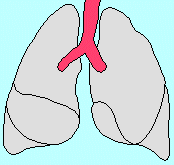|
Administering Positive Airway Pressure Therapy |
|
The administration of effective positive airway pressure therapy requires careful planning, individualized patient assessment and implementation, and thoughtful follow-up. Planning During the planning process, the need for positive airway pressure therapy should be determined, and desired therapeutic outcomes should be set. Clinical findings indicating a need for positive airway pressure therapy intended to treat atelectasis include: |
 |
- Change in breath sounds consistent with atelectasis
- Change in vital signs-increase in breathing rate, tachycardia, fever
- Abnormal chest X-ray indicating with atelectasis, mucus plugging, or infiltrates
- Deterioration in arterial oxygenation or SpO2
The outcome measures indicating successful application of therapy treating atclectasis are basically the exact opposite of these indicators. Specifically, an improvement in breath sounds, an improvement in vital signs, resolution of abnormal X-ray findings, and the restoration of normal oxygenation would all indicate that the therapy had achieved its goal.
Procedures
Patients receiving PEP therapy should be seated comfortably with elbows resisting on a flat surface. With the mask snugly placed over the patient's nose and mouth, the patient uses diaphragmatic breathing to inhale a volume 2 to 3 times larger than the normal tidal volume. The patient then slowly (not forcefully) exhales to the FRC through the flow resistor, keeping the positive expiratory pressure between 10 and 20 cm H2O. This procedure is repeated for 10 to 20 breaths, at which time the mask is removed and the patient performs 2 to 3 "huff" coughs.
This sequence is repeated 4 to 6 times for each PEP therapy session (10 to 20 minutes). Common strategies for PEP vary from twice to four times daily, with frequency determined by assessment of patient response to therapy. During acute exacerbations, therapy should be performed at increasing intervals rather than extending the length of the therapy sessions.
CPAP, whether used on an intermittent or continuous basis, is a complex and potentially hazardous approach to patient management. As with all therapies, the appropriate CPAP level for a given patient must be determined on an individual basis. Initial application and monitoring require a broader range of knowledge and skill than that required for simpler modes of lung expansion therapy.
Monitoring and Troubleshooting
As with other lung expansion therapies, monitoring of positive airway pressure involves both the equipment performance and patient response:
Equipment performance:
- Inspiratory pressure (CPAP only)
- Expiratory pressure
- Source gas flow setting (CPAP only)
- FIO2 (CPAP only)
- Nebulizer (if used)
Patient response:
- Breathing rate and pattern
- Minute volume (CPAP only) peak flow or FEV,/FVC%
- Pulse rate and rhythm (from EKG if available)
- Sputum-quantity, color, consistency and odor
- Mental function
- Skin color
- Breath sounds
- Blood pressure
- Sp02 (if hypoxemia is suspected)
- Blood gas analysis (if indicated)
- ICP (in patients for whom ICP is important)
- Chest X-ray
- Subjective response to therapy
The real danger CPAP poses is that of causing hypoventilation, and clinical experience with the long-term administration of CPAP indicates that patients must be able to maintain adequate excretion of carbon dioxide on their own if the therapy is to be successful.
As a result, patients receiving CPAP must be closely and continuously monitored for any of these side-effects. The essential components of CPAP devices include: a means to monitor the pressure delivered to the airways, and alarms to indicate the loss of pressure due to system disconnect or mechanical failure.
System leaks are the most common problems encountered with positive airway pressure therapies. If a mask is used, a tight seal must maintained (even though it may cause irritation or pain for some patients) in order to keep pressure levels above atmospheric. Any significant leaks in the system will result in the loss of positive airway pressure.
New nasal CPAP units have solved some of the comfort issues as well as as correction of leakage associated with CPAP, however its use intermittently for this purpose has not been well documented. A more serious problem with CPAP is the potential for causing gastric insufflation and aspiration of stomach contents. This potential hazard can be eliminated by use of a nasogastric tube.
The RCP must also ensure the CPAP system's flow is adequate to meet the patient's needs. Initially set it to 2 to 3 times the patient's minute ventilation, and thereafter flow adjustments are made by carefully observing the airway pressure. Flow is adequate when the system pressure drops no more than 1 to 2 cm H2O during inspiration.